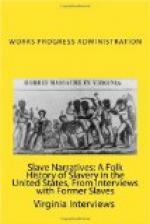“Mrs. Reynolds she was good to me. And since she’s gone looks like I’m gone too—gone to the dogs. Cause when Mrs. Reynolds got a dress for Miss Katie—got one for me too.
“My father was a soldier in the war. Last time I heard from him I know he was hauling salt to the breastworks. Yes, I was here in the war. That was all right to me but I wished a many a time I wasn’t here.
“I went to school two or three days in a week for about a term. But I didn’t learn to read much. Had to hire out and help raise my brother and sister. I’m goin’ to this here government school now. I goes every afternoon.
“Since I got old I can think bout the old times. It comes to me. I didn’t pay attention to nothin’ much when I was young.
“Oh Lord, I don’t know what’s goin’ to become of us old folks. Wasn’t for the Welfare, I don’t know what I’d do.
“I was sixteen when I married. I sure did marry young. I married young so I could see my chillun grown. I never married but once and I stayed a married woman forty-nine years to the very day my old man died. Lived with one man forty-nine years. I had my hand and heart full. I had a home of my own. How many chillun? Me? I had nine of my own and I raised other folks’ chillun. Oh, I been over this world right smart—first one thing and then another. I know a lot of white folks. They all been pretty good to me.”
Interviewer: Mary D. Hudgins
Person Interviewed: Mrs. Mary Jane (Mattie) Mooreman
Home: with son
Age: 90
“Yes, ma’am. I’ve been in Hot Springs, been in Hot Springs 57 years. That’s a long time. Lots of changes have come—I’ve seen lots of changes here—changed from wooden sidewalks and little wood buildings.
“Your name’s Hudgins? I knew the Hudginses—knew Miss Nora well. What’s that? Did I know Adeline? Did I know Adeline! Do you mean to tell me she’s still alive? Adeline! Why Miss Maud,” (addressing Mrs. Eisele, for whom she works—and who sat nearby to help in the interview) “Miss Maude, I tell you Adeline’s white, she’s white clean through!” (see interview with Adeline Blakeley, who incidentally is as black as “the ace of spades”—in pigmentation.) “Miss Maude, you never knew anybody like Adeline. She bossed those children and made them mind—just like they was hers. She took good care of them.” (Turning to the interviewer) “You know how the Hudgins always was about their children. Adeline thought every one of ’em was made out of gold—–made out of pure gold.
“She made ’em mind. I remember once, she was down on Central Avenue with Ross and he did southing or other that, wasn’t nice. She walked over to the umbrella stand, you remember how they used to have umbrellas for sale out in front of the stores. She grabbed an umbrella and she whipped Ross with it—she didn’t hurt him. Then she put it back in the stand and said to the man who ran the store, ’If that umbrella’s hurt, just charge it to Harve Hudgins.’ That’s the way Adeline was. So she’s still alive. Law how I’d like to see her. Bring me a picture of her. Oh Miss Mary, I’d love to have it.




